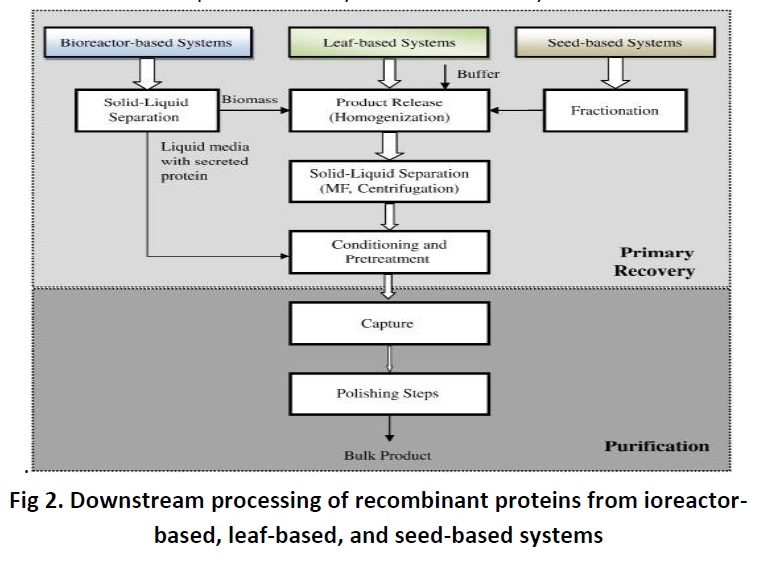Chapter: Basic Concept of Biotechnology : Plant Molecular Farming: A Promising Stratergy in Biotechnology
Use of non-chromatographic methods
Use of
non-chromatographic methods
Mostly
the non-chromatographic method involves capturing and partial purifying of
oleosin-fusion proteins by centrifugation (Van Rooijenand Moloney, 1995).
These fusions have oleosin proteins as N-terminal fusion partners that allow in vivo targeting and/or post-extraction
capture of the target protein on the surface of oil bodies (Boothe et al.,2010).
Purification of oil bodies with attached fusions is done by several washing
steps in aqueous solutions using centrifugation. Attached recombinant protein
can be released from oil bodies by proteolytic cleavage of the oleosin-target
protein linkage or by elution in the case of affinity bound proteins. The
affinity binding approach is exemplified by constructs developed recently that
contain an N-terminal anti-oleosin single chain antibody (scFv) as the fusion
partner. Following their elution from oil bodies these fusions can be cleaved
either chemically (e.g. acidic cleavage) or enzymatically to release the
recombinant protein ( Bootheet al., 2010 and
Nykiforuk et al.,
2011). The potential downside of these two strategies is
the need to cleave the recombinant protein from the oleosin or scFv fusion
partner. The cleavage precision and efficiency,whether chemical or enzymatic,
is typically less than 70% and results in reduced product yield. Subsequent
purification of released recombinant proteins from respective fusions is done
by standard adsorption chromatography. Other equally good examples of
non-chromatographic purification methods utilized unique protein properties
(size, hydrophobicity or stability) and host system properties to accomplish
enhanced separation efficiency. Lee and Forciniti
(2010) explored the use of aqueous two-phase (PEG/salt)
partitioning as a sole recovery and purification method of non-glycosylated mAb
expressed in corn seed. By manipulating the system composition, pH, and ionic
strength they managed to partially purify the antibody in a three-stage
process. The first two stages were typical two-phase partitioning with the
target protein concentration enriched in the bottom (aqueous salt phase) and
host impurities in the top (PEG) phase. These two-extraction protocols resulted
in a rather modest mAb purification of 1.3- and 1.4-fold, respectively. The
third stage consisted of mAb precipitation at the two-phase interface and
resulted in almost 10-fold purification. Overall, the three-stage processes
delivered 72% pure mAb with 49% yield. Clearly, an additional adsorption step,
most likely affinity chromatography, would be needed to purify the antibody for
biopharmaceutical applications. Aspelund and Glatz
(2010) demonstrated purification of recombinant collagen
from low pH corn extracts by cross-flow filtration. Diafiltration of corn
endosperm extracts at pH 3.1 by using 100-kDa MWCO membranes removed 96% of
host protein and resulted in 89% pure collagen. Improved purification of
collagen was achieved by protein precipitation of endosperm extracts with
sodium chloride at pH 2.1. Thus, the unique composition of endosperm extract
and molecular properties of collagen (high molecular weight and stability at
low pH) allowed the development of this extremely attractive and inexpensive
purification scheme.
Although
much progress has been made over the past seven years, downstream processing
still requires further attention and technological breakthroughs to fulfil the
long anticipated goal of low manufacturing cost for plant-derived recombinant proteins.
However, improvements in downstream processing alone will not suffice; high
protein expression levels and assured product fidelity are also necessary.

Related Topics